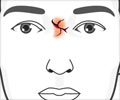UV rays emitted by the eyes could cause skin cancers found on the nose, says an Australian researcher. And the rays can be held at bay by wraparound sunglasses.
Eyes can trouble noses, such seems to be the latest understanding. For a Queensland University of Technology researcher says ultraviolet radiation from our eyes may be to blame for the higher than average rates of skin cancers found on our nose.
And how to protect our noses against our own eyes? Simple, wear wraparound sun glasses, says Dr Benjamin Birt, who recently completed his PhD with QUT's Faculty of Science.He found that high rates of basal cell carcinoma skin cancers on the sides of the nose could be due to ultraviolet (UV) radiation rays reflected off the eye.
"All surfaces reflect a certain amount of radiation, our eyes are no different," he said.
Dr Birt said the incidence of basal cell carcinoma (BCC), the most commonly occurring skin cancer in sub-tropical climates, was significantly higher on the side of the nose than other parts of the face and neck which were more directly exposed to sunlight.
"This could be explained by reflected radiation," he said.
In order to study the reflection of UV rays off the eye, Dr Birt made a cast of the front surface of his own eyeball.
Advertisement
"I discovered that the curved shape of the eye created a focussing effect, producing UV hot spots on the side of the nose," he said.
Advertisement
Dr Birt said the reflected rays hit predominately between the tear duct and the bridge of the nose.
"The next step is to study a much greater range of facial shapes and radiation angles than possible with the existing model," he said.
"I also hope the findings will be picked up by medical researchers so a population study can be undertaken."
In 2000-2001, Australians spent $264 million on treating non-melanoma skin cancers such as BCCs and more than 364,000 new cases were recorded in 2001.
Dr Birt said one way of protecting the nose was to cover the eyes with sunglasses.
"But sunglasses may be a friend or foe to your nose, depending on how well they are designed," he said.
"Good wraparound sunglasses reduce the amount of UV radiation reaching the eye from all angles.
"Non-wraparound sunglasses will block the UV entering the eye but due to more comfortable light levels the eyelids are open wide, thus allowing radiation entering the around the sides of the sunglasses to be reflected off the eyes on to the side of the nose."
Source-Medindia
LIN/M







